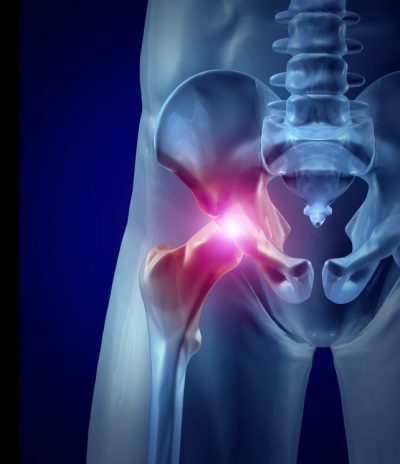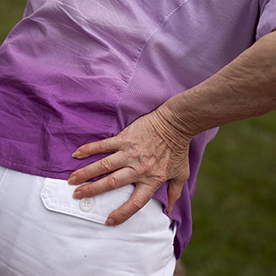Ask Dr. Gibbs: Do I have hip impingement?
As an orthopedic hip doctor in Tooele, Dr. Daniel Gibbs sees his fair share of hip injuries. From hip bursitis and arthritis to hip labral tears, snapping hip syndrome and hip impingement, Dr. Gibbs diagnoses and treats every kind of hip pain and condition at Heiden Orthopedics’ Tooele location.
Dr. Gibbs served as a team physician for the USC football team, the LA Kings and the LA Dodgers, and one of the most common causes of hip pain he’s seen in adolescents, adults and athletes of all ages is hip impingement. Also known as femoroacetabular impingement (FAI) or hip bone spurs, hip impingement can lead to even more degenerative hip conditions down the road.
What is hip impingement?

First, let’s review basic hip anatomy. The hip is a ball-and-socket joint, in which the ball is the head of the femur (thigh bone) and the socket is the acetabulum (part of the pelvis bone). The hip’s ball and socket are covered in articular cartilage, which is a tissue that helps the femur and pelvis bones glide against one another without friction. In a healthy hip, the ball of the femoral head fits perfectly in the acetabulum socket and the articular cartilage acts as a cushion during movement.
Additionally, the labrum – a ring of fibrocartilage that also helps cushion the hip joint and acts as a seal around the acetabulum – provides stability for the hip joint.
Hip impingement is a general term for when the ball and socket of the hip joint don’t fit together as they should. This causes friction between the head of the femur and the acetabulum, which can lead to a restricted range of motion, damaged cartilage, joint pain and arthritis.
A femoracetablular impingement (FAI) – a type of hip impingement – occurs when there is extra bone growth on the hip’s ball, socket or both. This overgrowth, called hip bone spurs, causes the hip bones to abnormally rub against one another and can lead to hip pain, labrum tears and osteoarthritis due to the breakdown of articular cartilage.
Hip Impingement FAQs with Dr. Gibbs
As a hip orthopedic surgeon, Dr. Gibbs regularly treats hip injuries and conditions, including hip bone spurs, at Heiden Orthopedics’ Tooele location. The following are common questions he is asked about hip impingement.
Are there different types of FAI?
Yes. There are three different types of FAI hip impingement.
Pincer hip impingement – Pincer impingement is when a bone spur grows on the acetabulum and extends past the normal rim of the socket. This type of growth can also crush the labrum.
Cam hip impingement – Cam impingement occurs when a bone spur grows on the edge of the femoral head. This type of growth grinds down the hip’s cartilage, as the femoral head cannot glide smoothly against the acetabulum.
Combined pincer/cam hip impingement – A combined hip impingement occurs when both pincer and cam impingements are present.
What causes hip impingement?
There are four main causes of hip impingement.
- The ball and/or socket of the hip joint is structured abnormally at birth.
- The hip socket develops abnormally during the childhood growing years.
- FAI develops over time. It is believed that hip bone spurs often develop during adolescence when the growth plates are open and physical activities irritate the more open joint.
- A femoral retrotorsion – an abnormal twist of the femur – can cause hip impingement.
What does hip impingement feel like? What are common hip impingement symptoms?

Hip Impingement Symptoms:
- Stiffness in the thigh, hip or groin
- Popping and/or clicking in the front of the hip during movement
- Pain in the front of the thigh and/or down the buttocks
- Loss of full range of motion
FAI Hip Impingement Symptoms:
- Stiffness in the hip
- Limping
- Hip pain that worsens with long periods of sitting or physical activity
- Locking, clicking or catching sensation in the hip joint
- Difficulty bending over or walking uphill
- Low back pain
- Pain at the SI (sacroiliac joint on the back of the pelvis)
How do orthopedic doctors diagnose hip impingement?
Your orthopedic hip doctor should first conduct a hip impingement test by bringing your knee toward your chest and rotating it inward. If this movement recreates your hip pain, you most likely have an impingement.
To determine whether you have FAI, your doctor might then order an X-ray, CT scan or MRI scan.
How do you treat hip impingement? Are there specific hip impingement stretching exercises?

Most orthopedic hip surgeons will first recommend nonsurgical treatment for your hip impingement or FAI. These include changes in activity, nonsteroidal anti-inflammatory drugs (NAIDs) like ibuprofen, cortisone injections and physical therapy. A physical therapist can teach you specific hip impingement stretching exercises that may help relieve your symptoms.
Will I need hip impingement surgery?
If your tests show hip joint damage and nonsurgical treatments don’t relieve your pain, hip surgery may be necessary to reshape your femur and/or acetabulum, repair the labrum and repair damage to your articular cartilage. These surgeries are done arthroscopically, though some severe cases may require an open operation.
What is the average hip impingement surgery recovery time?
This varies depending on the condition of your hip joint pre-surgery, type of surgery and your activity level, but recovery time for most impingement surgeries is four to six months for a full recovery.
If you have any more questions for Dr. Gibbs about hip impingement syndrome or any other hip issues, please contact us today.
Leave a Reply